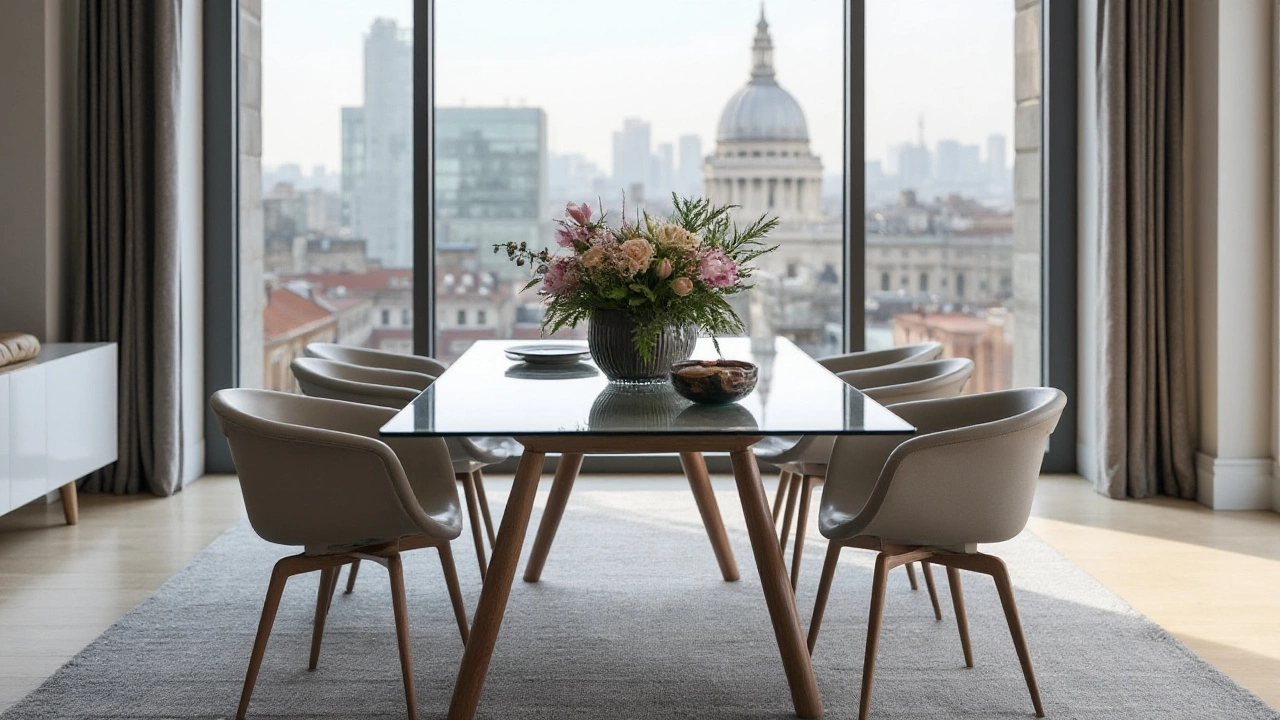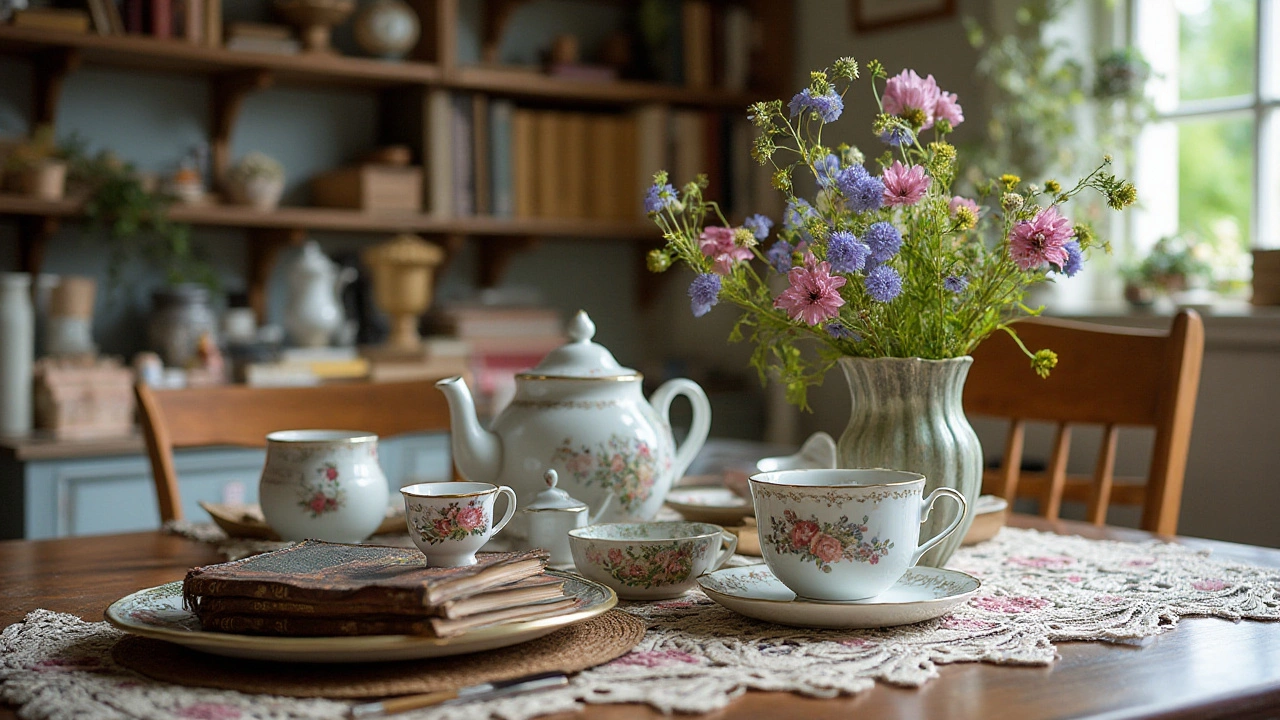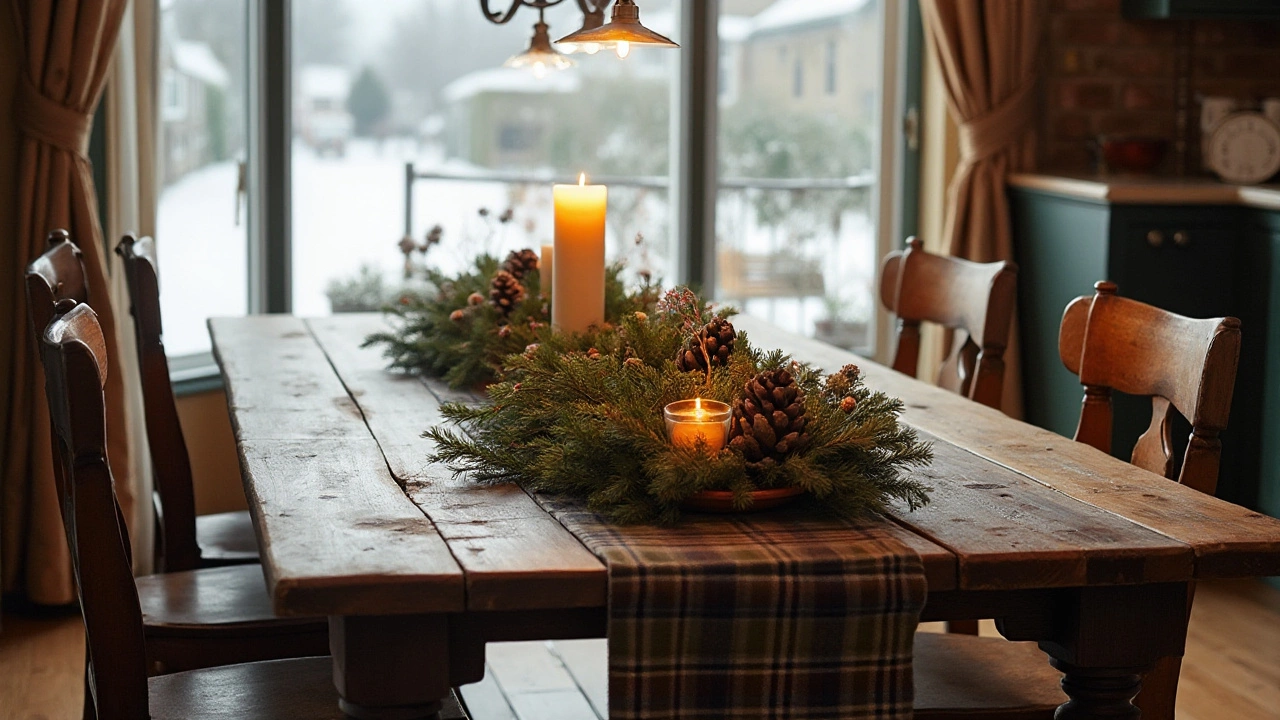A dining room table holds more potential than just hosting meals. When not in use, it can serve as an anchor for your room's decor, complementing the rest of your home's interior style. Imagine turning it into a canvas where your personality and creativity can shine, perhaps reflecting the changing seasons or displaying treasures that tell a story.
The trick is to find a balance between keeping things stylish yet not overly cluttered. This article will explore various decorating ideas, from seasonal theming to thoughtful use of textiles and unique centerpiece arrangements. Whether you aspire to a modern, minimalist look or a vibrant, eclectic ambiance, your dining table can become a standout feature, all without being a dumping ground or a forgotten piece of furniture.
- Understanding Space and Style
- Seasonal Themes and Decorations
- Centerpiece Ideas
- Use of Textiles and Layers
- Incorporating Personal Collections
- Balancing Aesthetics with Functionality
Understanding Space and Style
Decorating an unused dining room table begins with understanding the space and its inherent style. It's not just about placing random items on top of the table; it’s about creating a scene that resonates with the room's mood while reflecting your personal taste. Consider the size and shape of your table. Is it round, extending warmth to the space, or is it more rectangular, offering a formal and elegant appeal? Each form sets a different tone. A round table facilitates a harmonious flow of energy, making it an ideal candidate for more organic and relaxed arrangements, while a rectangular one might call for symmetry and order in its decorations.
Next, consider the dining table decoration in relation to the room’s existing decor elements. Are the walls painted in a bold color, or do they feature wallpaper patterns that already demand attention? In this case, opting for subtle and more cohesive table decorations might come off as wise to prevent overwhelming the senses. Remember, the idea is to add to the beauty of the room, not drown it out. The trick is to balance and complement what’s already there. Consider using colors from the surrounding space or even textures that echo other furniture pieces—like the wood grain of a sideboard or the metal accents of a light fixture.
Aligning with Personal Style
Style is deeply personal, and your table decor should feel like an extension of your personality. If your aesthetic leans towards modern minimalist design, focus on clean lines with a purposeful selection of objects. A few monochrome items or a sculptural vase could suffice as an entire ensemble. For those drawn to a more eclectic approach, mix and match textures and forms, incorporating pieces from your travels or cherished heirlooms. According to interior design guru Nate Berkus, "Your home should tell the story of who you are, and be a collection of what you love." This is quite true for your dining room table, which offers you yet another blank canvas for storytelling.Complementing with Proportion and Scale
Also significant is the scale of the items placed on the table. A large centerpiece might be a fantastic way to add character, but it should be balanced with smaller elements scattered around it, ensuring an even distribution of visual weight. A room's impression often changes with the slightest shift in where objects are placed. Inviting different heights, colors, and textures creates layers and adds depth to the decor. It's often about the art of visibility—an eye-catching piece draws immediate attention, while coordinating peripheral items provide continuity and intrigue. Practicing with these dynamics is enjoyable and can often lead to surprising discoveries about your preferences and style inclinations.Seasonal Themes and Decorations
Decorating your dining room table according to the seasons not only brings a refreshing change to your home but also links your living space with the natural ebb and flow of time. This subtle transformation doesn't have to be expensive or overly complicated; sometimes, the simplest additions can make the most significant impact. As the seasons shift, consider how your table can embrace those changes, providing a warm reflection of the outside world right within your home.
Spring, for example, is the perfect time to introduce elements of renewal and new beginnings. A classic approach is to adorn your table with fresh flowers – tulips and daffodils are customary choices that burst with color and energy, signaling the end of winter's gloom. Pair these with pastel-colored napkins or a soft-hued table runner to complete a look that's light and refreshing. Using natural elements like small pots of herbs or pastel-painted eggs can also evoke a sense of freshness reminiscent of springtime gardens.
Summer brings with it vibrant, bright colors. Consider using bold table runners or placemats that pop against the wooden grain of your table. Fresh fruit bowls filled with bright oranges, lemons, and limes add not just color but a fresh aroma to the room. Seasonal decorations for summer can also include elements like seashells in clear vases or even a single, large sunflower as your centerpiece. This season is all about vibrancy, so don't shy away from using bold colors and textures.
As autumn arrives, it invites the warm hues of nature indoors. Golden leaves, rich oranges, deep reds, and browns dominate this time of year. A simple yet striking centerpiece can be created using gourds, tiny pumpkins, or even a cornucopia filled with apples and leaves. Candles in autumnal colors can add a cozy glow, making your dining area feel inviting and warm against the crispness of fall air. Perhaps weave in rustic elements like burlap runners or plaid napkins to integrate a farmhouse aesthetic.
Winter, often synonymous with elegance and festivity, is an opportunity to reflect those qualities in your dining room. Opt for a minimalist approach with a simple yet elegant white tablecloth, accompanied by silver or gold accents. A
quote by interior designer Charlotte Moss highlights, "In decorating, details are everything, so pay attention to the little things."Consider using pine cones, sprigs of evergreens, or even a garland as the foundation of your centerpiece. Adding candles or fairy lights can create a magical atmosphere, enhancing the serene beauty of winter.
Incorporating seasonal themes and decorations doesn't only transform your unused table styling but also invites the outside world into your home. Through thoughtful design, your dining room can echo the subtle changes in the seasons and bring a dynamic touch that keeps your home ever-evolving and in tune with nature.

Centerpiece Ideas
Creating a stunning centerpiece is an art form in itself, capable of transforming a dining table from a simple surface into a conversation starter. One of the easiest ways to begin is by thinking about what brings you joy and incorporating those elements. Flowers are a classic choice, with endless varieties to match any season or mood. Opting for a simple glass vase filled with fresh blooms provides color and life, making your dining table decoration truly stand out. Consider the textures and hues they bring to your room; a mix of wildflowers can evoke a rustic charm, while a single type of flower in abundance can create a more formal, elegant atmosphere.
Diversifying materials can add depth and interest. Incorporate elements like candles, which not only add a sense of warmth but also allow you to play with height and light. Lanterns or candle holders in metal, wood, or glass can be united with seasonal accessories, like small pumpkins in fall or glittering ornaments during the holiday season. This multidimensional approach ensures that your unused table styling feels dynamic, not static.
Consider the appeal of modern centerpiece styles, like terrariums, which offer a self-contained ecosystem that's both educational and decorative. If you're someone who enjoys crafting, building a terrarium can serve as a rewarding project. It's not only a beautiful home decor tip but also a sustainable choice as you nurture your own indoor garden. To add a personal touch, use family heirlooms or travel souvenirs within your centerpiece, seamlessly integrating memory and meaning into everyday life.
"A centerpiece should be as personal as a piece of art. It tells your story, silently."—Anonymous
If you're looking to embrace a more artistic flair, consider sculptural or abstract pieces that echo the textures and colors around your home. Metal sculptures or ceramic art can act as focal points, drawing the eye and starting conversations. These pieces can change with different decor themes throughout the year, keeping your unused dining space interesting and relevant. You could even rotate your centerpiece with the changing seasons, ensuring it remains fresh and aligned with the mood.
In terms of size and proportion, it’s important to find a balance. A centerpiece should not obstruct the view across the table, especially if it's a smaller space. Aim for visual impact without overwhelming the surroundings. Often, a long, linear arrangement suits rectangular tables, while round tables can be enhanced with a circular or singular bold piece. For those who appreciate minimalism, a clean, simplistic look with one standout item can be quite effective, leaving room for the table’s natural finish and grain.
Finally, variety is key. Change elements often to keep the setting fresh. This doesn't have to mean a total overhaul; sometimes just altering a few components like swapping in seasonal flowers or adjusting the color palette can make a significant difference. Ultimately, the goal is to have your dining room table be a reflection of your life and home, shining brightly even when dinner isn't being served.
Use of Textiles and Layers
When considering ways to transform your dining table when not in use, the strategic use of textiles and layers can bring a room to life through texture and color. Textiles, whether they be tablecloths, runners, or napkins, offer both a functional and decorative touch. The layering concept is about adding depth and visual interest that can make an otherwise plain area feel dynamic and inviting. Start with a high-quality tablecloth as a base, something that fits the aesthetic of your home while also resisting daily wear and tear. Cotton and linen are everyday favorites due to their durability, though silk can add a touch of elegance for special occasions. On top of your tablecloth, consider adding a runner. Whether you prefer these in complementary or contrasting colors, they can break uniformity and create a focal point.
Layering doesn’t stop with just one or two items; it's about creatively using multiple fabrics, much like layering an outfit. Place placemats or chargers for an added dimension with subtle color contrasts or intriguing textures. They serve as an excellent stage for any centerpiece while allowing for a quick setup when you have impromptu guests. Cloth napkins folded elaborately or casually placed can further intensify the richness of your table ensemble. Choosing the right color scheme plays a significant role too. For cohesive dining room ideas, match your textiles with the room's palette or season-specific colors. For a modern look, go for monochrome or neutral tones. A splash of bold, warm hues can inject energy into the room, especially when used strategically in spaces craving a little pizzazz.
It's often said by design experts that 'textiles are the clothes of a home', which extends to your dining table as well.
"Without texture, light can get caught up in monotony," notes renowned designer, Jane Lockhart. "Textiles help tell a story by not just seeing but feeling the space." This approach extends the use of textiles beyond the visual, inviting touch as part of the dining experience, even when meals aren’t being served. Bring in different materials, patterns, and weaves to capture interest. Velvet can evoke a sense of luxury, while burlap creates a rustic charm. Explore paisley prints, florals, or geometric designs based on personal tastes.An understanding of fabrics and blending can also reflect your personality and style, emphasizing a home that is truly yours.

Incorporating Personal Collections
Transform your dining room into a space that whispers tales of your life's journey, not just when it's adorned for a feast, but even when it stands silently awaiting the next gathering. Displaying personal collections on your dining table can infuse a sense of nostalgia and warmth into the room, inviting guests to learn more about you the moment they step in. It's a chance to show items that you have gathered over the years, from vintage teapots inherited from family to modern art pieces picked up during travels. Emphasizing your home decor tips allows for a narrative that's entirely yours, turning your table into a talking piece that facilitates sharing of memories.
Choosing the right items is crucial. While it can be tempting to display everything, focusing on a few select pieces often yields the best results. Think about items that not only mirror your interests but also harmonize with the room's dining room ideas. For instance, if you love seaside escapes, a few sand-filled glass jars or shells can evoke memories of the coast. Those who read voraciously might prefer to stack beautiful editions of favorite books or add a single statement book as a decorative piece. Consider the size and shape of both the table and the objects, ensuring they fit well proportionally. A large, sprawling collection can overwhelm a small table, while a single tiny object might look lost on a vast one.
Mixing texture and color can also play a significant role in making your displays pop. Contrasts like smooth ceramics against rustic wood or colorful glass against neutral runners can create dynamic and visually appealing setups. Don't hesitate to integrate seasonal elements, like small pumpkins in the fall or sprigs of pine in the winter, to add a touch of the current season while staying true to your collection's theme. It's about striking the right balance—allowing your dining table decoration to complement the room's existing decor without overshadowing other elements.
"Your home should tell the story of who you are, and be a collection of what you love," says Nate Berkus, a renowned American interior designer. Let your table reflect this sentiment, acting as a tableau that showcases your world in miniature.
Preservation is key when it comes to integrating beloved pieces into an often-used space like the dining room. Use protective covers or plates for delicate items, and ensure heavier pieces are stable to prevent any accidents. Over time, you may feel like changing things up. Rotate collections as the seasons change, or whenever the mood strikes you, to keep the space feeling fresh and exciting. Storing other collections nearby or having a designated spot in the room for easy swapping can be a helpful way to keep things dynamic without the decor becoming tiresome.
Ultimately, when you bring personal collections into your dining space, it's not just about design. It's a candid expression of who you are, told through the items you choose to showcase. From archaeological finds for history buffs to botanical specimens for nature lovers, every collection has the potential to make your dining room table, even in its idle state, a vibrant reflection of you. Let your table set the tone of an ever-evolving story, always ready to welcome guests into your world, one piece at a time.
Balancing Aesthetics with Functionality
When it comes to decorating your dining table, achieving a harmonious balance between aesthetics and functionality is key to maintaining a practical yet beautiful home. While it’s tempting to fill the tabletop with a myriad of decorative items, practicality should not be overlooked. This is because every decor choice impacts the daily use of this vital piece of dining room furniture. Begin by deciding on a theme that complements the rest of your home while ensuring that the table can still serve its primary function without needing constant rearrangement.
Consider incorporating multi-purpose items into your decor. For example, a stylish fruit bowl or a set of elegant candles can enhance the aesthetic appeal of the table while offering a practical use. The concept of layering is particularly effective in achieving this balance. Start with a table runner as a base layer, which adds both color and texture. Choose one that suits the season, whether it's a cozy, thicker fabric for winter or a lighter, more vibrant one for summer. Then, add layers with items like coasters, placemats, or decorative trays, all the while keeping in mind the overall look you want to achieve.
Another approach to blending functionality with aesthetics is through the thoughtful selection of a centerpiece. The centerpiece acts as the focal point of your dining table decoration, anchoring the entire look without sacrificing space. Select something that doesn’t need to be moved each time the table is utilized but is also a conversation starter, such as an intricately designed sculpture or a simple yet elegant vase of flowers. Rotate these items with the seasons to keep your decor fresh and engaging. As interior designer Nate Berkus once said,
"Your home should tell the story of who you are, and be a collection of what you love."Let this principle guide your decor choices and make sure they resonate with your personal taste.
If your tastes tend towards a more minimalist approach, select a few standout pieces that hold meaning or interest. These can vary from handcrafted ceramics to antique finds. They should not overcrowd the table but instead, support a calming and orderly ambiance. Regularly interact with your decorations to ensure they remain clean and vibrant, and don't let them collect dust or fade into the background. This regular maintenance guarantees that your dining table remains a highlight of your home all year round, effortlessly blending beauty with utility.
